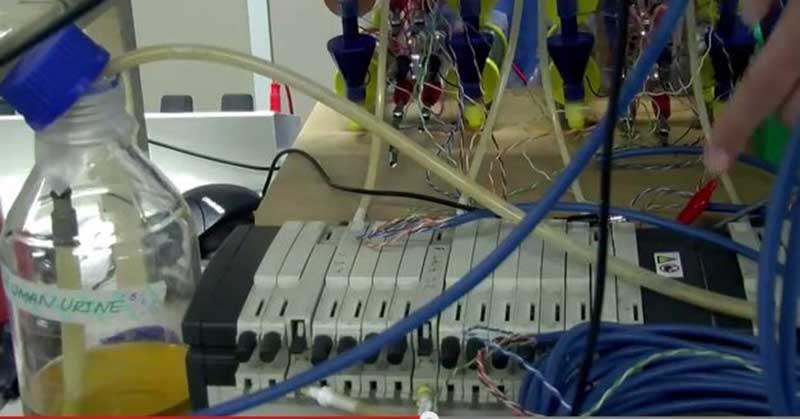- Harnessing the power of photosynthesis with the Bioo plant pot
- 3D-printed graphene can offer paper-thin, flexible storage possibilities
- Water dew batteries – generating power from humidity in the air
- Skin friction could power wearables through daily activities
- Will we be charging our smartphones with Bill Gates’ urine powered batteries?
- Phone batteries that charge while you talk
- The future of batteries is just around the corner
Technology is growing increasingly advanced and there seems to be no limit to what can be achieved. One thing, however, that hampers the evolution of technology is that our batteries haven’t kept pace with the technological developments of the past few decades. While operating systems and chips are becoming more efficient with each passing day, we still don’t get much more than two days of power before we have to charge our smartphones. The lithium-ion batteries that power our electric vehicles are not much better. The good news is that we seem to be on the verge of a power revolution. Universities and tech companies all over the globe are investing in the development of alternative battery technology. With a plethora of new generation batteries underway, we could soon see anything from gold nanowire to urine batteries powering our gadgets. Let’s have a look at the exciting developments taking place in the future of batteries.
Harnessing the power of photosynthesis with the Bioo plant pot
Using photosynthesis to charge a battery sounds like a scene from the movie Avatar. However, the Bioo plant pot is no science fiction. In fact, it is already on the market. With the Bioo Lite plant pot, developed by Arkyne Technologies in Barcelona, you can actually charge your phone. The device can produce up to three charges per day at 3.5 volts and 500 milliamps. The pot makes use of the organic materials of the plant reacting with the water, resulting in electricity that can power a typical USB port that’s beautifully disguised as a small rock. The pot plant generates power during the day as well as at night so users are able to charge their devices anytime.

Gold nanowire batteries never need to be replaced
Nanowire batteries typically break down when recharching, but scientists at the University of California have now developed a generation nanowire batteries that can withstand thousands of recharges. Following the new discovery, scientists have started coating coat gold nanowires (which are a thousand times thinner than a human hair) with a gel-electrolyte to prevent them from damage. During more than 200,000 test recharges, these batteries showed no signs of degradation whatsoever. The breakthrough work could lead to commercial batteries with an incredible lifespan, even batteries that need no replacement at all. Imagine the possibilities for our phones and computers but also our appliances, future electric cars and even aeroplanes and spacecraft!
3D-printed graphene can offer paper-thin, flexible storage possibilities
Researchers at the Swinburne University in Australia have developed a new super battery with flexible energy storage capabilities. The new super-capacitor charges in seconds, can be charged millions of times and is able to store as much power per kilogram as a lithium-ion battery. Instead of costly lithium, the super battery uses graphene. Graphene is a type of carbon, made up of planar sheets of one atom thick, with the atoms arranged in a honeycomb pattern. These sheets have a large surface area and can therefore store much more energy than other capacitors. In order to produce the super-capacitors, large scale production of graphene is required. This is now possible at low cost, thanks to 3D printing technology. One of the most amazing benefits of graphene is that it is extremely strong, flexible and as thin as paper. This makes it the perfect material to power wearables such as watch straps or belts. It could even be woven into clothing! And, not unimportantly: graphene is also easy on the environment.
Sodium-ion batteries – using the salt of the earth to desalinate water
When it comes to charging smartphones and laptops, lithium-ion batteries have been serving us well. They are, however, not ideal for large-scale energy storage as lithium is scarce and expensive. Sodium-ion batteries are heavier than their lithium-containing counterparts but sodium is far more abundant and a thousand times cheaper, making it a very attractive alternative. In an exciting new development, the salt batteries are now also being tested for use in water desalination. Reversed osmosis, the most widely used desalination method, uses a membrane to filter out salt from water, which is an expensive process that requires a lot of energy. The sodium-ion battery offers an energy and cost-efficient alternative for the extraction of salt: when the battery discharges, the chloride and sodium ions are pulled from the water into one chamber, leaving the desalinated water behind in the other. Experiments with the sodium-ion batteries showed that it was possible to recover approximately 80 percent of desalinated water from seawater.
[ARTLGNC_video width=”745″ height=”450″]https://www.youtube.com/watch?v=RW1Xugey8j0
Water dew batteries – generating power from humidity in the air
Scientists at the MIT have developed a method in which they can generate power from dew. They discovered that condensed water drops jump back and forth between specially treated copper plates and, in doing so, pick up electrical charge. The scientists are now able to harness that charge by using interleaved metal plates to generate power from humidity in the air. Initial trials have yielded limited amounts of power – 15 picowatts – but according to Nenad Milijkovic, who is spearheading the research project, they should eventually be able to produce at least one microwatt. Although exciting, this water dew technology won’t keep your smartphone powered all day or replace your current charger just yet. For a phone to fully charge, you would have to use a charger the size of the lid of a cooler box and leave it to charge for twelve hours. If time is not a problem, the battery could be useful in remote areas where no other power source is available. If you would combine this technology with vibration energy and waste heat, you would theoretically never need to actively charge a battery again.
Skin friction could power wearables through daily activities
Just as you think you’ve read it all, here comes yet another weird way to harness energy – using the power of friction from someone’s skin. A small flexible generator translates the movement of muscles into power, using the wearer’s skin as a charge collector. The generator, which is the size of a postage stamp, uses static electricity to convert motion energy into electric power. Skin-friction could power wearables by simple daily activities such as cycling and walking but even just by holding something or talking. An example: a finger tap on a person’s skin could produce enough power to illuminate no less than 12 LED light bulbs. Scientists have already showcased a skin friction powered wearable.
Will we be charging our smartphones with Bill Gates’ urine powered batteries?
Batteries powered by human waste? Believe it. The Bill Gates Foundation is investing money into researching urine-powered batteries which produce sufficient power to charge a cell phone. Simply put, urine is passed into the battery cells via tubes. Then, using microbial fuel cells, micro-organisms break down the urine and produce energy. Then the broken down version of the excrement is expelled in such a way that it is harmless to the environment. Who would have thought that our porcelain thrones would ever produce a source of electricity that can power our gadgets and perhaps even our cars? But with Bill Gates involved, how can we not expect big things?

Phone batteries that charge while you talk
Even ambient sound can be used to charge devices. Researchers at the Queen Mary University in the UK, in collaboration with Nokia, recently designed a smartphone that can be charged by sounds. This is possible thanks to ‘the piezoelectric effect’, in which zinc oxide creates a voltage as it contracts and expands, which can be used to help power devices. The researchers created nano-rod forms of zinc oxide that can harvest ‘waste’ noise that we hear around us – such as human voices – and translate this into electricity. This effectively means that we could soon be charging our smartphones simply by chatting to our friends.
Organic flow batteries make use of rhubarb-like molecules
During a recent MIT discovery, researchers created an organic flow battery. The device uses quinone molecules, which are virtually identical to the molecules found in rhubarb and other organic material. Not only was the battery made with this organic material just as efficient as metal, it could also be produced in large quantities, for only $27 per kilowatt-hour. Normal metal batteries cost a whopping $700 per kilowatt-hour. It is hoped that with further development, these batteries can be scaled up to industrial levels, so that they can help make wind and solar energy more economically viable. Organic batteries could just be the future of power.
Power your devices with sand from the sea
Scientists at the University of California, Riverside’s Bourns College of Engineering, have developed a battery that is like the lithium-ion ones in our smartphones – but performs three times better. Instead of graphite, this battery uses sand, which makes it low cost and environmentally friendly. The idea of using sand was inspired by that it is primarily made up of quartz, or silicon dioxide. Previously, the scientist team had been focusing their efforts on nano-silicon, which storage capacity is ten times greater than that of current materials. This is however complicated to produce in large quantities and it degrades very quickly. The team then turned their focus on beach sand. They ground it down to the nanometre scale and subjected it to a purification process which turned it into purified quartz. Next, they added ground magnesium and salt to the powdered quartz. The powder was then heated and the oxygen removed, resulting in pure silicon. This is three-dimensional and porous, which increases the lifespan as well as the performance of batteries.
The future of batteries is just around the corner
We all want unlimited pools of energy in small packages and we want it clean, safe and cheap. In order to quench our thirst for mobile power, we will, however, need to find ground breaking energy storage technology such as superior fuel cells, improved electro-chemical batteries or even atomic fusion batteries. Thanks to all the research that goes into alternative battery technology, we may just be on the cusp of such a breakthrough sooner than we think. One thing’s for sure: the future of batteries is just around the corner.
Share via:



